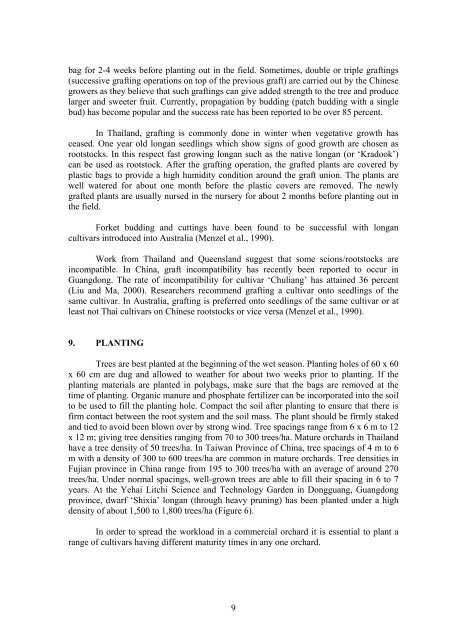Longan production in Asia - United Nations in Indonesia
Longan production in Asia - United Nations in Indonesia
Longan production in Asia - United Nations in Indonesia
Create successful ePaper yourself
Turn your PDF publications into a flip-book with our unique Google optimized e-Paper software.
ag for 2-4 weeks before plant<strong>in</strong>g out <strong>in</strong> the field. Sometimes, double or triple graft<strong>in</strong>gs<br />
(successive graft<strong>in</strong>g operations on top of the previous graft) are carried out by the Ch<strong>in</strong>ese<br />
growers as they believe that such graft<strong>in</strong>gs can give added strength to the tree and produce<br />
larger and sweeter fruit. Currently, propagation by budd<strong>in</strong>g (patch budd<strong>in</strong>g with a s<strong>in</strong>gle<br />
bud) has become popular and the success rate has been reported to be over 85 percent.<br />
In Thailand, graft<strong>in</strong>g is commonly done <strong>in</strong> w<strong>in</strong>ter when vegetative growth has<br />
ceased. One year old longan seedl<strong>in</strong>gs which show signs of good growth are chosen as<br />
rootstocks. In this respect fast grow<strong>in</strong>g longan such as the native longan (or ‘Kradook’)<br />
can be used as rootstock. After the graft<strong>in</strong>g operation, the grafted plants are covered by<br />
plastic bags to provide a high humidity condition around the graft union. The plants are<br />
well watered for about one month before the plastic covers are removed. The newly<br />
grafted plants are usually nursed <strong>in</strong> the nursery for about 2 months before plant<strong>in</strong>g out <strong>in</strong><br />
the field.<br />
Forket budd<strong>in</strong>g and cutt<strong>in</strong>gs have been found to be successful with longan<br />
cultivars <strong>in</strong>troduced <strong>in</strong>to Australia (Menzel et al., 1990).<br />
Work from Thailand and Queensland suggest that some scions/rootstocks are<br />
<strong>in</strong>compatible. In Ch<strong>in</strong>a, graft <strong>in</strong>compatibility has recently been reported to occur <strong>in</strong><br />
Guangdong. The rate of <strong>in</strong>compatibility for cultivar ‘Chuliang’ has atta<strong>in</strong>ed 36 percent<br />
(Liu and Ma, 2000). Researchers recommend graft<strong>in</strong>g a cultivar onto seedl<strong>in</strong>gs of the<br />
same cultivar. In Australia, graft<strong>in</strong>g is preferred onto seedl<strong>in</strong>gs of the same cultivar or at<br />
least not Thai cultivars on Ch<strong>in</strong>ese rootstocks or vice versa (Menzel et al., 1990).<br />
9. PLANTING<br />
Trees are best planted at the beg<strong>in</strong>n<strong>in</strong>g of the wet season. Plant<strong>in</strong>g holes of 60 x 60<br />
x 60 cm are dug and allowed to weather for about two weeks prior to plant<strong>in</strong>g. If the<br />
plant<strong>in</strong>g materials are planted <strong>in</strong> polybags, make sure that the bags are removed at the<br />
time of plant<strong>in</strong>g. Organic manure and phosphate fertilizer can be <strong>in</strong>corporated <strong>in</strong>to the soil<br />
to be used to fill the plant<strong>in</strong>g hole. Compact the soil after plant<strong>in</strong>g to ensure that there is<br />
firm contact between the root system and the soil mass. The plant should be firmly staked<br />
and tied to avoid been blown over by strong w<strong>in</strong>d. Tree spac<strong>in</strong>gs range from 6 x 6 m to 12<br />
x 12 m; giv<strong>in</strong>g tree densities rang<strong>in</strong>g from 70 to 300 trees/ha. Mature orchards <strong>in</strong> Thailand<br />
have a tree density of 50 trees/ha. In Taiwan Prov<strong>in</strong>ce of Ch<strong>in</strong>a, tree spac<strong>in</strong>gs of 4 m to 6<br />
m with a density of 300 to 600 trees/ha are common <strong>in</strong> mature orchards. Tree densities <strong>in</strong><br />
Fujian prov<strong>in</strong>ce <strong>in</strong> Ch<strong>in</strong>a range from 195 to 300 trees/ha with an average of around 270<br />
trees/ha. Under normal spac<strong>in</strong>gs, well-grown trees are able to fill their spac<strong>in</strong>g <strong>in</strong> 6 to 7<br />
years. At the Yehai Litchi Science and Technology Garden <strong>in</strong> Dongguang, Guangdong<br />
prov<strong>in</strong>ce, dwarf ‘Shixia’ longan (through heavy prun<strong>in</strong>g) has been planted under a high<br />
density of about 1,500 to 1,800 trees/ha (Figure 6).<br />
In order to spread the workload <strong>in</strong> a commercial orchard it is essential to plant a<br />
range of cultivars hav<strong>in</strong>g different maturity times <strong>in</strong> any one orchard.<br />
9
















